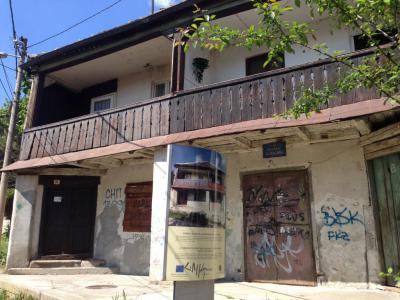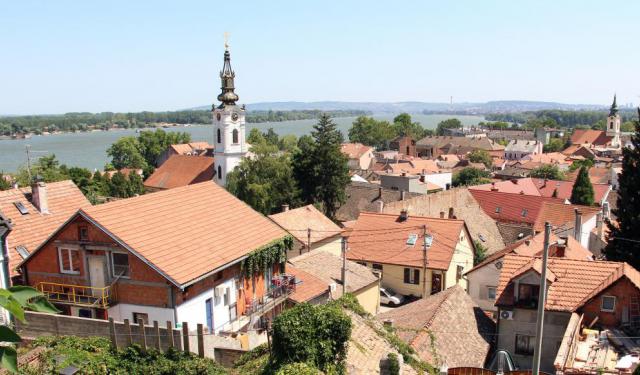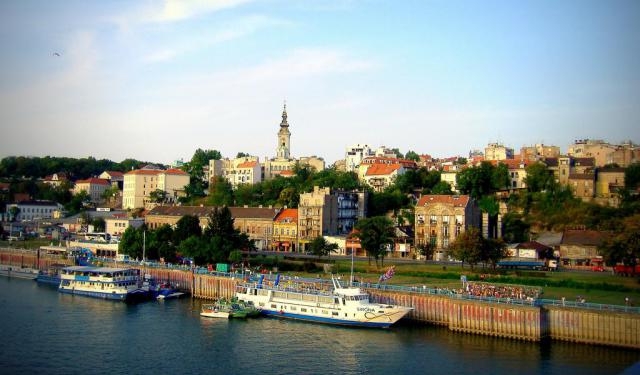White Bear Tavern, Belgrade
White Bear Tavern, a historic former tavern (kafana) located in the Zemun municipality of Belgrade, stands as a testament to the region's rich history. First mentioned in historical records in 1658 by French traveler Michel Quiclet, it is recognized as the oldest existing building in modern Belgrade, excluding the Belgrade Fortress. Although the precise construction date is uncertain, it is believed to have been built in the first half of the 17th century, during the period of Ottoman rule.
The building initially served as one of the three major inns in Zemun and was noted for its size. It gained prominence in historical records when Prince Eugene of Savoy stayed there in 1717 while preparing for the siege of Belgrade. Over time, the building underwent various name changes and transformations, notably becoming a traditional Balkan tavern (kafana) in the 18th century.
The architecture of the White Bear Tavern is a prime example of the Balkan Bondruk style, characterized by timber structures filled with unbaked bricks. This one-story edifice is notable for preserving the architectural style of its time and is the only remaining example in the Old Core of Zemun.
Beneath the tavern, a network of underground corridors adds to its historical significance. These were used for storage and refrigeration, utilizing ice cuts from the Danube during winter to preserve food and drinks. One of the lagums, accessible from the first-floor living room of the building's present tenants, is still used as a larder due to its constant year-round temperature.
On 25 August 2023, the state government declared White Bear Tavern a cultural monument.
The building initially served as one of the three major inns in Zemun and was noted for its size. It gained prominence in historical records when Prince Eugene of Savoy stayed there in 1717 while preparing for the siege of Belgrade. Over time, the building underwent various name changes and transformations, notably becoming a traditional Balkan tavern (kafana) in the 18th century.
The architecture of the White Bear Tavern is a prime example of the Balkan Bondruk style, characterized by timber structures filled with unbaked bricks. This one-story edifice is notable for preserving the architectural style of its time and is the only remaining example in the Old Core of Zemun.
Beneath the tavern, a network of underground corridors adds to its historical significance. These were used for storage and refrigeration, utilizing ice cuts from the Danube during winter to preserve food and drinks. One of the lagums, accessible from the first-floor living room of the building's present tenants, is still used as a larder due to its constant year-round temperature.
On 25 August 2023, the state government declared White Bear Tavern a cultural monument.
Want to visit this sight? Check out these Self-Guided Walking Tours in Belgrade. Alternatively, you can download the mobile app "GPSmyCity: Walks in 1K+ Cities" from Apple App Store or Google Play Store. The app turns your mobile device to a personal tour guide and it works offline, so no data plan is needed when traveling abroad.
White Bear Tavern on Map
Sight Name: White Bear Tavern
Sight Location: Belgrade, Serbia (See walking tours in Belgrade)
Sight Type: Attraction/Landmark
Guide(s) Containing This Sight:
Sight Location: Belgrade, Serbia (See walking tours in Belgrade)
Sight Type: Attraction/Landmark
Guide(s) Containing This Sight:
Walking Tours in Belgrade, Serbia
Create Your Own Walk in Belgrade
Creating your own self-guided walk in Belgrade is easy and fun. Choose the city attractions that you want to see and a walk route map will be created just for you. You can even set your hotel as the start point of the walk.
Belgrade Old Town (Zemun) Walking Tour
Belgrade's Old Town, also known as Zemun, spread around Gardos Hill, is one of the city's oldest parts. Throughout the centuries, as the Balkans were part first of the Roman, then the Byzantine, and then the Austro-Hungarian empires, this area transformed into a beautiful neighborhood with narrow streets, cute buildings, and breathtaking views opening from the hill onto the Old Town and... view more
Tour Duration: 2 Hour(s)
Travel Distance: 2.4 Km or 1.5 Miles
Tour Duration: 2 Hour(s)
Travel Distance: 2.4 Km or 1.5 Miles
Kalemegdan Park and Belgrade Fortress Walking Tour
The most beautiful park in Belgrade, Kalemegdan Park, or simply Kalemegdan, is also the largest park and the most important cultural and historical complex in the city. The actual park occupies a smaller portion, in the southern corner, of another, grander monument – the Belgrade Fortress (which is some two millennia older).
The fortress itself, often erroneously referred to, even by the... view more
Tour Duration: 2 Hour(s)
Travel Distance: 2.1 Km or 1.3 Miles
The fortress itself, often erroneously referred to, even by the... view more
Tour Duration: 2 Hour(s)
Travel Distance: 2.1 Km or 1.3 Miles
Belgrade Introduction Walking Tour
Belgrade has been a city of strategic importance for millennia with its location at the confluence of the Sava and Danube rivers. In fact, it is one of the oldest continually inhabited cities on the planet.
Nomadic tribes inhabited the area as far back as 20,000 to 50,000 years ago. Some of these may have been Neanderthals rather than modern humans. By the sixth century BC, the Vinca culture... view more
Tour Duration: 2 Hour(s)
Travel Distance: 4.0 Km or 2.5 Miles
Nomadic tribes inhabited the area as far back as 20,000 to 50,000 years ago. Some of these may have been Neanderthals rather than modern humans. By the sixth century BC, the Vinca culture... view more
Tour Duration: 2 Hour(s)
Travel Distance: 4.0 Km or 2.5 Miles






